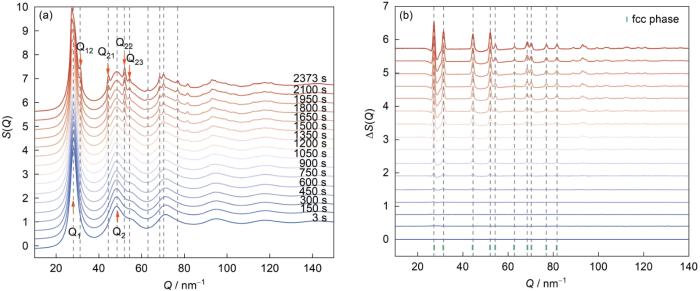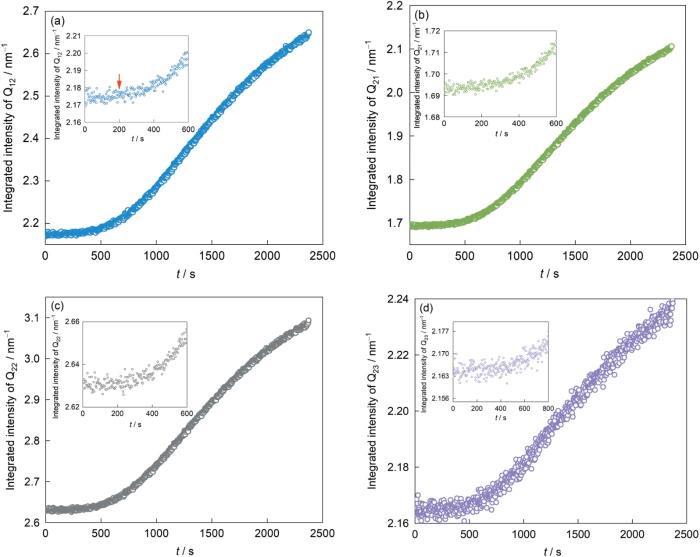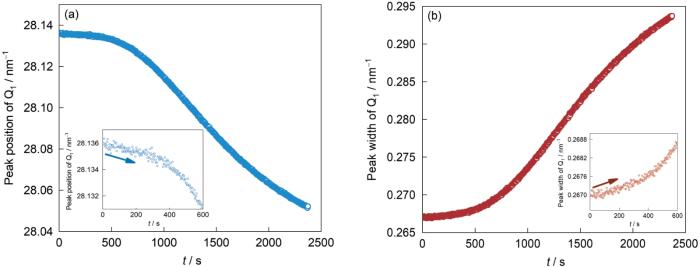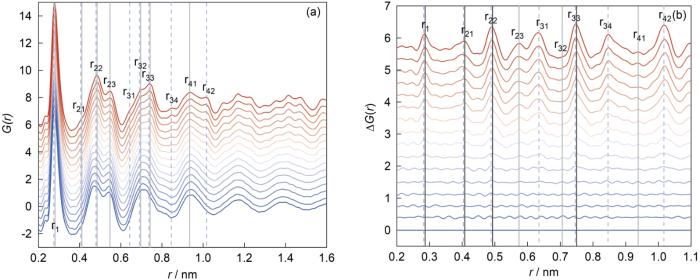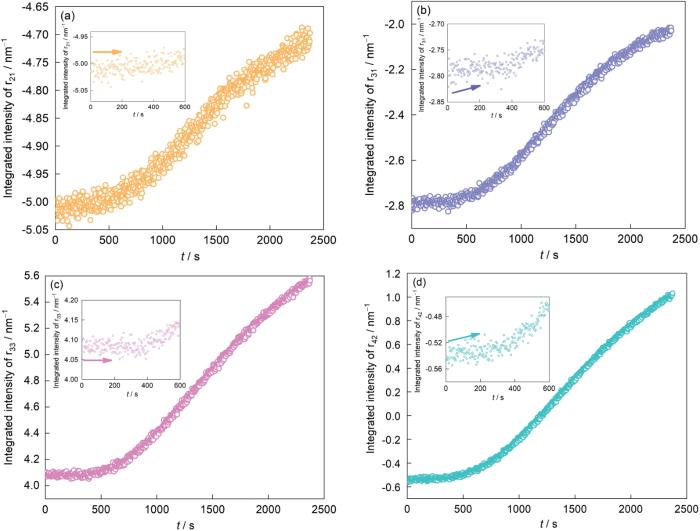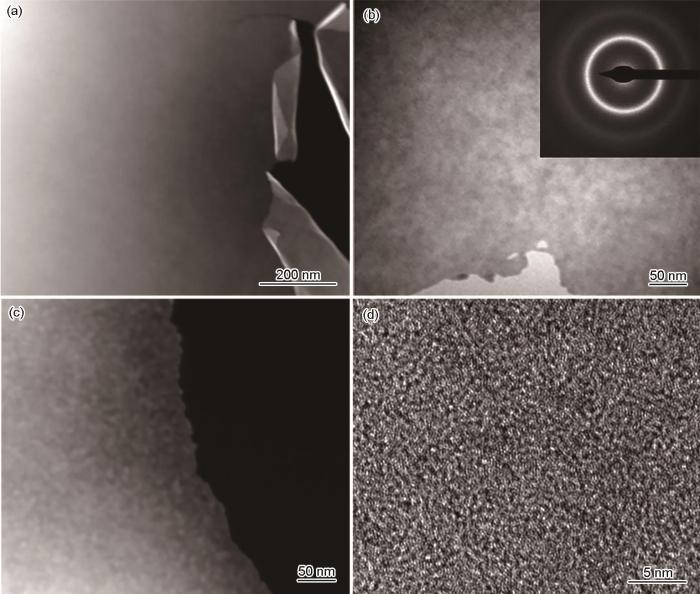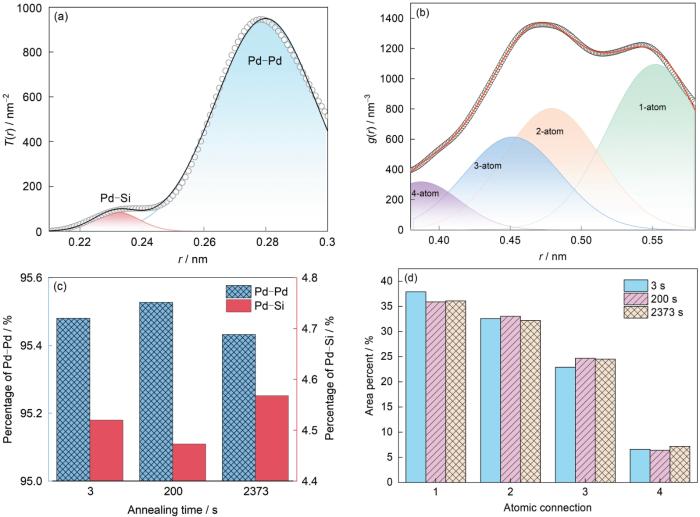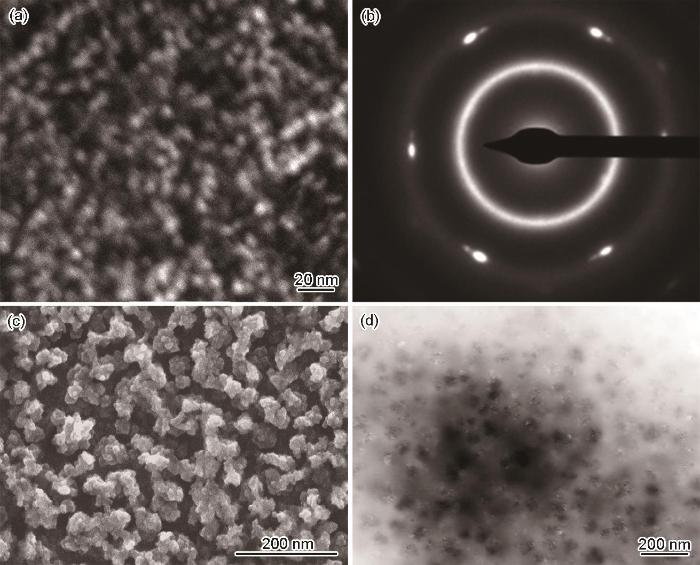液-液相变(liquid-liquid phase transition,LLPT)是由一种液体转变为另一种液体,伴随着密度和有序度变化的物理过程,被认为会普遍发生于各种液体体系[1~7]。据报道,不同的外场作用可以诱发LLPT的产生,如压力与温度。在高压下,由于共价键受压会诱导短程结构变化[7~13],LLPT会发生于具有共价键的液体中[14~16]。此外,具有离子键的体系在高压下也会发生LLPT过程[17,18]。另一方面,熔体在加热[19]或冷却过程(温度降低至超过冷液相区)[20~25],一些合金液体也会发生LLPT。通过差式扫描量热分析(DSC)研究发现,具有优异玻璃形成能力的Zr46Cu38Al8Ag8[21]、Zr52.5Cu17.9Ni14.6Al10Ti5[22]以及Pd41.25Ni41.25P17.5[23] (原子分数,%)金属玻璃在超过冷液体区间会出现异常放热峰。进一步利用原位同步小角/广角X射线散射与小角中子散射,前期研究揭示出该异常放热峰的物理本质是LLPT过程引发的超过冷液体在原子乃至纳米尺度的结构演变。
关于合金液体系统LLPT的报道大多集中在具有优异玻璃形成能力的多组元合金。由于多组元成分不可避免地给体系引入化学复杂性,导致难以精确地破译合金液体LLPT过程的结构变化。因此,原位研究组分简单的二元合金液体在超过冷液体区间的结构变化,将对理解LLPT的内在机制起关键作用。但二元合金液体在超过冷液相区间发生LLPT鲜有报道[3]。主要原因在于组元减少后玻璃形成能力有限,使得过冷液体快速晶化而干扰LLPT过程,导致在超过冷液体区间发生的结构变化通常被认为是一种结晶过程。因此,研究二元合金体系LLPT亟待解决的问题,就是在面对较快的结晶动力学干扰下,如何准确、及时地捕捉到结晶之前的液体结构变化。
1 实验方法
实验以Pd82Si18二元金属玻璃作为研究对象,其制备方法如下:采用纯度超过99.99% (质量分数)的Pd固体颗粒和Si固体颗粒为原材料,在高纯Ar气氛中经高温熔炼制得Pd82Si18合金铸锭;随后,将铸锭置于石英管中加热到1423 K,并用B2O3作为包覆介质进行连续净化处理4 h以上;将经过包覆处理的Pd82Si18样品密封在薄壁石英管中重新熔融,熔融后随石英管迅速进行水淬处理,制得直径为1 mm的金属玻璃棒。为分析样品在超过冷液相区的LLPT,分别对其进行原位和非原位热处理。原位热处理实验在美国阿贡国家实验室先进光源(APS)的11-ID-C线站进行,样品放置在Linkam加热台内,在638 K以及Ar气氛下进行等温退火,同时开展原位高能同步辐射X射线衍射。采集数据使用的光束尺寸为500 μm × 500 μm,波长为0.01173 nm。利用Perkin Elmer非晶硅探测器获取二维衍射图案,衍射实验的时间分辨率为0.5 s/frame。分别使用Fit2D[26]和PDFgetX2软件[27]进行数据处理,通过抹除坏像素点、图像积分、扣除背景,并进行斜入射、吸收、多重散射、荧光、康普顿(Compton)散射和劳厄(Laue)修正等,从二维衍射图案中得到静态散射结构因子S(Q) (其中,Q为倒易空间散射波矢,本文涉及的有关散射波矢Q曲线图上的数据均使用Q的模)。在非原位热处理实验中,装有熔融Pd82Si18的密封石英管从熔点以上温度迅速置于预设在Pd82Si18过冷液相区温度(663 K)的锡浴炉进行退火60 s,接着将样品和石英管迅速进行水淬。样品经打磨抛光后使用体积分数为1∶1的HNO3与CH3COOH混合腐蚀液腐蚀表面,利用QUANTA 400F 扫描电镜(SEM)表征腐蚀过的非原位退火样品的形貌。TEM样品通过电解双喷抛光制备,使用的电解液为16%HClO4 + 42%CH3COOH + 42%C2H5OH (体积分数)。电解抛光温度通过液氮降温维持在243 K。电解抛光后的TEM样品继续置于Model 695离子减薄仪下用Ar+进行轰击,加速电压为3.8 keV。最后,利用TF-20高分辨率透射电镜(HRTEM,电压200 kV)观察试样的微观组织形貌。
2 实验结果
图1a为Pd82Si18金属玻璃在等温退火过程中的散射结构因子图谱,Q1和Q2分别表示第1和第2个衍射宽峰。随着退火时间的增加,样品逐渐晶化,导致在Q1和Q2衍射峰的基础上形成新的衍射肩峰,分别表示为Q12、Q21、Q22和Q23。由于新出现的晶体峰较小,容易被非晶衍射宽峰的背景影响而不易被观察到。因此为了更清晰地观察退火后形成的晶体峰,在图1b中绘制了原位散射结构因子的差分图谱(ΔS(Q)) (ΔS(Q) = S(Q, t) - S(Q, t0),其中t和t0分别为退火时间和退火初始状态(t0 = 3 s))。在图1b中,Q ≤ 80 nm-1范围内出现的晶体峰已用虚线标出,可以发现它们与fcc结构Pd晶体的峰位(图1b底部的短线)重合,表明等温退火过程产生的结晶相为fcc结构的Pd晶体。为了分析结晶的起始时间,图2展示了Q12、Q21、Q22和Q23积分强度随退火时间的变化规律。图2的插图给出了退火开始时积分强度的放大图。可以看出,在退火时间t ≤ 200 s时,Q12、Q21、Q22和Q23积分强度均保持不变,即在结晶之前经历了一段结晶孕育期;t > 200 s时,积分强度逐渐上升,预示着结晶开始 (在图2a插图中用箭头标记)。
图1
图1
Pd82Si18金属玻璃在超过冷液相区等温退火过程中的同步辐射X射线散射结构因子(S(Q))及结构因子差分(ΔS(Q))图谱
Fig.1
Profiles of structure factor(S(Q)) (a) and the differential structure factor (ΔS(Q)) (b) during the isothermal annealing for Pd82Si18 metallic glass (Annealing time for each line shown in Fig.1b corresponds to that in Fig.1a. Q—momentum transfer modulus; ΔS(Q) obtained by subtracting the respective S(Q) profile at the beginning of isothermal annealing (3 s); Q1 and Q2—the 1st and 2nd diffraction peaks;Q12, Q21, Q22, and Q23—crystallization peaks developed after 200 s)
图2
图2
Pd82Si18金属玻璃在超过冷液相区等温退火过程,S(Q)曲线上不同结晶峰积分强度的演变分析图
Fig.2
Analyses of the integrated intensity of crystalline peaks Q12 (a), Q21 (b), Q22 (c), and Q23 (d) in S(Q)during the isothermal annealing for Pd82Si18 metallic glass (Insets show the enlarged views of integrated intensity at the beginning of isothermal annealing. The arrow in inset of Fig.2a marks the time when crystallization begins. t—isothermal annealing time)
图3
图3
Pd82Si18金属玻璃在超过冷液相区等温退火过程中第一衍射峰Q1峰位与峰宽演变图
Fig.3
Evolution of peak position (a) and peak width (b) of the 1st diffraction peak Q1 during the isothermal annealing for Pd82Si18 metallic glass (Insets show the enlarged views of peak position and peak width at the beginning of isothermal annealing. Arrows show the trends of the peak position and peak width before crystallization)
除了散射结构因子S(Q)反映的倒易空间信息,本工作进一步从实空间角度分析结晶之前金属玻璃超过冷液体细微的结构变化。对S(Q)进行Fourier变换,可获得实空间约化对分布函数G(r)[32]:
式中,r为实空间内原子对之间的距离,Qmax为最大散射波矢的模,Qmin为最小散射波矢的模。G(r)代表了在给定距离r处找到另一个原子的概率,反映了样品的短程-中程序尺度(一般来说r ≤ 0.5 nm (最近邻和次近邻原子壳层距离)代表短程序,0.5 nm < r ≤ 2 nm为中程序)的原子结构[33]。图4a为Pd82Si18样品在不同退火时间(每条曲线对应的退火时间与图1a相对应)下的G(r)曲线。在退火初始状态,G(r)曲线存在一些代表非晶结构的特征峰,分别是r1、r22、r23、r32和r41。随着退火时间的增加,样品逐渐晶化,导致G(r)曲线出现一些新生成的峰,分别是r21、r31、r33、r34和r42,代表了晶体结构中的特征原子对。图4b为G(r)曲线的差分图谱(ΔG(r)) (ΔG(r) = G(r, t) - G(r, t0)),可以更清楚地观察到非晶特征峰和晶体特征峰的变化,其中属于晶体(即fcc Pd)短程到中程序尺度原子对的峰用虚线标记。此外,代表六元三帽三棱柱(six-membered tricapped trigonal prism,6M-TTP)的非晶结构模型中近邻原子对的峰,在图4a和b中用实线做了标记(后续将进行讨论)。
图4
图4
Pd82Si18金属玻璃在超过冷液相区等温退火过程中的约化对分布函数(PDF)图谱(G(r))及差分图谱(ΔG(r))
Fig.4
Reduced pair distribution function G(r) (a) and differential profiles ΔG(r) (b) for Pd82Si18 metallic glass during isothermal annealing (The annealing time for each line corresponds to that in Fig.1a. r—the distance between two atoms; G(r)—reduced pair distribution function; ΔG(r) obtained by subtracting the respective G(r) profile at the beginning of isothermal annealing (3 s); r1—the first shell; r21, r31, r33, r34, r42—the crystalline peaks in G(r); r22, r23, r32, r41—the amorphous peaks in G(r); the dashed lines and solid lines represent atomic pairs in fcc and 6M-TTP (six-membered tricapped trigonal prism) structure, respectively)
为了详细分析退火过程G(r)曲线不同原子对的变化规律,对属于非晶结构的特征峰和属于晶体结构的特征峰分别进行积分,它们的积分强度随退火时间的变化趋势分别如图5和6所示。退火时间t > 200 s时,属于晶体结构的特征峰(r21、r31、r33、r42)积分强度均迅速增加,但属于非晶结构的特征峰积分强度则有升(r1、r22)有降(r23、r32)。t ≤ 200 s时,属于非晶结构的特征峰积分强度则均在下降,意味着对应的结构有序度降低。相反,属于晶体结构的特征峰,部分在结晶之前积分强度基本保持不变,例如r21 (图6a)、r33 (图6c),而另一些峰的积分强度在结晶开始之前逐渐增长,如r31 (图6b)、r42 (图6d),表明在结晶前的超过冷液体状态时,中程序尺度上具有部分晶体序的特征原子对逐渐形成。值得注意的是,某些原子对不仅存在于非晶相中,也存在于fcc晶体相中(例如r1和r22)。然而,在结晶之前它们的强度减小,在结晶之后强度增加。这表明在结晶之前,超过冷液体中的短程到中程尺度结构并不是单调趋向于形成近似晶体结构的有序过程。相反,它们在结晶前的液体结构演变过程中形成了更复杂的结构构型。
图5
图5
约化对分布函数G(r)上属于非晶结构的特征峰(即退火前超过冷液体中已经存在的特征原子对)的积分强度演变图
Fig.5
Integrated intensity of atomic pairs in the original amorphous phase peaks of r1 (a), r22 (b), r23 (c), and r32 (d) (Insets show the enlarged views of integrated intensity of corresponding atomic pairs at the beginning of isothermal annealing. Arrows indicate the trends of integrated intensity before crystallization)
图6
图6
约化对分布函数G(r)上属于晶体结构的特征峰(即随着结晶过程新产生的特征原子对)的积分强度演变图
Fig.6
Integrated intensity of atomic pairs in the newly formed crystalline peaks of r21 (a), r31 (b), r33 (c), and r42 (d) (Insets show the enlarged views of integrated intensity of corresponding atomic pairs at the beginning of isothermal annealing. Arrows indicate the trend of integrated intensity before crystallization)
为了进一步分析短程-中程序尺度的结构变化规律,表1总结了所有近邻原子对的积分强度随退火过程的演化趋势。其中F代表fcc晶体中存在的原子对,T表示6M-TTP模型的原子对,6M-TTP是Pd-Ni-P金属玻璃中最新破译的一种结构模型[34,35]。图4的实线标记了6M-TTP特征原子对的峰位,与实验得到的Pd82Si18非晶结构存在多处峰位置重叠,具体为r1、r21、r22、r23、r32、r33、r41,表明6M-TTP结构也存在于Pd-Si金属玻璃体系。表1结果显示Pd82Si18非晶结构可以用fcc和6M-TTP结构的短程到中程序结构进行组合,这与早期研究[36]中发现的Pd80Si20金属玻璃的结构模型具备fcc团簇和TTP团簇是一致的。通过分析表1中退火时间t ≤ 200 s 阶段的峰强度变化规律,可以发现一些在中程序尺度与fcc结构接近的原子-原子关联逐渐形成,而6M-TTP相关的原子-原子关联则在减少。
表1 约化对分布函数中不同峰的积分强度在结晶前后的变化趋势
Table 1
| Peak | Position nm | Cluster structure | t ≤ 200 s | t > 200 s |
|---|---|---|---|---|
| r1 | 0.278 | F + T | ↓ | ↑ |
| r21 | 0.406 | F + T | ▁ | ↑ |
| r22 | 0.486 | F + T | ↓ | ↑ |
| r23 | 0.547 | T | ↓ | ↓ |
| r31 | 0.638 | F | ↑ | ↓ |
| r32 | 0.702 | T | ↓ | ↓ |
| r33 | 0.742 | F + T | ▁ | ↑ |
| r34 | 0.846 | F | ▁ | ↑ |
| r41 | 0.938 | T | ↓ | ↓ |
| r42 | 0.101 | F | ↑ | ↑ |
Note: The upward arrow means the integrated intensity of corresponding peaks increased. The downward arrow stands for the integrated intensity of corresponding peaks decreased. The short line means the integrated intensity of corresponding peaks almost unchanged. F—fcc, T—six-membered tricapped triangle prism (6M-TTP)
为了进一步了解退火过程中特别是结晶前液体的微观结构变化,对非原位退火的样品进行了TEM表征,并与铸态样品进行对比,相关结果见图7。图7a是Pd82Si18金属玻璃铸态样品的高角环形暗场扫描透射电子显微镜(HAADF-STEM)像,显示出均匀的纳米尺度结构。图7b是样品在超过冷液相区退火60 s后的明场TEM (BF-TEM)像,可以明显看出纳米尺度图像衬度的起伏,说明退火后出现了纳米尺度的结构不均匀性。图7c是在超过冷液相区退火60 s后样品的HAADF-STEM像,也可以清晰地观察到纳米尺度的结构不均匀性。图7b右上角插图是退火后样品对应的选区电子衍射(SAED)花样,呈现出典型的非晶弥散环,排除了结晶的可能性。图7d为对应样品的HRTEM像,显示出样品原子结构排列无序,同样证实了退火60 s后Pd82Si18金属玻璃样品无纳米晶析出。
图7
图7
Pd82Si18金属玻璃的高角环形暗场-扫描透射电镜(HAADF-STEM)像、TEM明场像及HRTEM像
Fig.7
High-angle dark-field scanning transmission electron microscopy (HAADF-STEM) image of as-cast sample Pd82Si18 metallic glass (a); bright-field TEM image (b), HAADF-STEM image (c), and HRTEM image (d) of Pd82Si18 metallic glass annealed at 663 K for 60 s (Inset in Fig.7b shows the corresponding SAED pattern)
3 分析讨论
同步辐射结果发现,在结晶之前Q1峰位随着退火时间延长偏向较小的Q值,意味着液体发生膨胀(图3a),这可归因于LLPT过程中原子在短程-中程尺度结构重排产生的额外自由体积。图3b中Q1在结晶之前的展宽预示着新液相中原子的关联长度减小,这是由于LLPT过程形成了与原始相不同的短程到中程序结构,破坏了初始状态下液体原子团簇之间的连接。基于G(r)多个原子壳层在200 s之前的积分强度变化分析(表1)可知,LLPT可能引发了Pd82Si18金属玻璃中6M-TTP结构向类似于fcc晶体的中程序结构转变,使得与fcc对应的原子-原子关联结构增强(r21、r42积分强度增加)。与此相反,短程序结构则呈现出不同于中程序的结构演变,近邻原子对r1的积分强度显示,其在LLPT过程下降,而在结晶过程增加,意味着LLPT过程短程序结构并非向fcc晶体结构短程序演变。
径向分布函数T(r)可以反映出近邻原子对概率分布。将G(r)转换成T(r) (
图8
图8
不同退火时间对应的径向分布函数T(r)第一壳层与对分布函数g(r)第二壳层Gaussian拟合分布图
Fig.8
Gaussian fitting results for the first shell of T(r) and the second shell g(r) (T(r)—radial distribution function, g(r)—pair distribution function)
(a, b) fitting results of the first shell (a) and the second shell (b) of the sample Pd82Si18 that annealed for 200 s (1-atom—vertex-shared mode, 2-atom—edge-shared mode, 3-atom—face-shared mode, 4-atom—intercross-shared mode)
(c) percentage of the Pd-Si and Pd-Pd atomic pairs obtained from the first shell fitting result of the sample Pd82Si18 annealed at 3 s, 200 s, and 2373 s
(d) percent of 1-4 atomic connection obtained from the second shell fitting result of sample annealed at 3 s, 200 s, and 2373 s
图9a为非原位663 K退火后Pd82Si18合金在氩离子轰击后的微观形貌(暗场像)。由图可见,其处于部分结晶状态,晶体之间相互连接且具有相同的晶面取向,在TEM暗场像下呈现出明亮的网络状结构。该网络结构的尺寸同样在纳米尺度,与图7b和c中的退火非晶样品的结构类似,表明它们之间存在潜在联系[39]。图9b为对应的SAED花样,同时观察到了非晶的弥散衍射环和fcc晶体的衍射斑点,证实了离子轰击后的样品属于非晶-晶体两相共存状态。此外,与多晶样品中通常观察到的均匀分散的衍射斑点有所不同,图9b的衍射环中显示出明亮的高度对称衍射斑点,这是fcc纳米晶体具有相同取向的结果。以上结果证实了LLPT过程产生了2个液相,结构尺寸小至5 nm。经过离子轰击后,其中一个不稳定的液相晶化形成具有相同取向的fcc纳米晶,另一个液相保留为非晶基体。图9c和d分别为在663 K长时间退火结晶后,Pd82Si18样品的SEM和HAADF-STEM像。表明LLPT可以诱发生成高密度的晶核,进而析出高密度纳米晶。
图9
图9
Pd82Si18样品经离子轰击后的TEM暗场像和SAED花样,及Pd82Si18样品663 K退火结晶后的SEM像和HAADF-STEM像
Fig.9
Dark-field TEM image (a) and SAED pattern (b) of the Pd82Si18 sample after ion milling, and SEM image (c) and the HAADF-STEM image (d) of the crystallized Pd82Si18 sample annealed at 663 K
在前人[39~45]的研究中,因为受实验条件限制以及较快的结晶动力学等因素影响,难以准确地捕捉到Pd-Si结晶之前的微观结构变化,导致该二元体系金属玻璃的液态相变一直具有争议。针对这一问题,有研究[46,47]报道了在超过冷液相区会发生相分离,相应的结构尺度也在纳米尺度,但报道中并未显示出成分区别或小角散射信号的明显增加,因此排除了该体系在2 nm尺度发生相分离的可能性。受益于高时间分辨原位同步辐射X射线衍射技术,本工作能够准确发现Pd82Si18金属玻璃在结晶之前发生的精细结构变化,证明了LLPT的发生。非原位退火处理后样品的TEM像也间接证明了LLPT导致的两相共存状态,为该二元合金系统中LLPT的存在提供了有力证据,并揭示了LLPT过程多尺度微观结构的演变规律。
4 结论
(1) 液-液相变存在于Pd82Si18金属玻璃超过冷液相区退火过程。
(2) 散射结构因子随退火的演变规律显示,液-液相变会导致液体体积膨胀和原子关联长度减小。
(3) 对分布函数随退火的演变规律显示,液-液相变过程中,在中程序尺度存在与fcc结构接近的原子-原子关联逐渐形成,短程序尺度结构则变得更加无序。
(4) 透射电子显微镜发现液-液相变过程存在2种液相共存,其中一相在离子束的轰击下更容易结晶,形成晶体-非晶网络状结构。
参考文献
General view of a liquid-liquid phase transition
[J].
Liquid-liquid phase transition: Evidence from simulations
[J].
On the abundance and general nature of the liquid-liquid phase transition in molecular systems
[J].
Femtosecond X-ray diffraction reveals a liquid-liquid phase transition in phase-change materials
[J].In phase-change memory devices, a material is cycled between glassy and crystalline states. The highly temperature-dependent kinetics of its crystallization process enables application in memory technology, but the transition has not been resolved on an atomic scale. Using femtosecond x-ray diffraction and ab initio computer simulations, we determined the time-dependent pair-correlation function of phase-change materials throughout the melt-quenching and crystallization process. We found a liquid-liquid phase transition in the phase-change materials AgInSbTe and GeSb at 660 and 610 kelvin, respectively. The transition is predominantly caused by the onset of Peierls distortions, the amplitude of which correlates with an increase of the apparent activation energy of diffusivity. This reveals a relationship between atomic structure and kinetics, enabling a systematic optimization of the memory-switching kinetics.Copyright © 2019 The Authors, some rights reserved; exclusive licensee American Association for the Advancement of Science. No claim to original U.S. Government Works.
Structure origin of a transition of classic-to-avalanche nucleation in Zr-Cu-Al bulk metallic glasses
[J].
Advances in the study of supercooled water
[J].
Structural studies and polymorphism in amorphous solids and liquids at high pressure
[J].When amorphous materials are compressed their structures are expected to change in response to densification. In some cases, the changes in amorphous structure can be discontinuous and they can even have the character of first-order phase transitions. This is a phenomenon referred to as polyamorphism. Most evidence for polyamorphic transitions between low and high density liquids or analogous transformations between amorphous forms of the same substance to date has been indirect and based on the changes in thermodynamic and other structure-related properties with pressure. Recent studies using advanced X-ray and neutron scattering methods combined with molecular dynamics simulations are now revealing the details of structural changes in polyamorphic systems as a function of pressure. Various "two state" or "two species" models are used to understand the anomalous densification behaviour of liquids with melting curve maxima or regions of negative melting slope. Thermodynamic analysis of the two state model leads to the possibility of low- to high-density liquid transitions caused by differences in bulk thermodynamic properties between different amorphous forms and on the degree of cooperativity between low- and high-density structural configurations. The potential occurrence of first-order transitions between supercooled liquids is identified as a critical-like phenomenon. In this tutorial review we discuss the background to polyamorphism, incorporating the experimental observations, simulation studies and the two-state models. We also describe work carried on several systems that are considered to be polyamorphic.
First-order liquid-liquid phase transition in compressed nitrogen
[J].
High-pressure melting curve of nitrogen and the liquid-liquid phase transition
[J].
An apparently first-order transition between two amorphous phases of ice induced by pressure
[J].
Visual observations of the amorphous-amorphous transition in H2O under pressure
[J].The vapor-deposited low-density amorphous phase of H(2)O was directly compressed at 77 kelvin with a diamond-anvil cell, and the boundary between the low-density amorphous phase and the high-density amorphous phase was observed while the sample was warmed under compression. The transition from the low-density amorphous phase to the high-density amorphous phase was distinct and reversible in an apparently narrow pressure range at approximately 130 to approximately 150 kelvin, which provided experimental evidence for polymorphism in amorphous H(2)O.
High-pressure transformations in simple melts
[J].
Structure and phase boundaries of compressed liquid hydrogen
[J].
Experimental observation of the liquid-liquid transition in bulk supercooled water under pressure
[J].We prepared bulk samples of supercooled liquid water under pressure by isochoric heating of high-density amorphous ice to temperatures of 205 ± 10 kelvin, using an infrared femtosecond laser. Because the sample density is preserved during the ultrafast heating, we could estimate an initial internal pressure of 2.5 to 3.5 kilobar in the high-density liquid phase. After heating, the sample expanded rapidly, and we captured the resulting decompression process with femtosecond x-ray laser pulses at different pump-probe delay times. A discontinuous structural change occurred in which low-density liquid domains appeared and grew on time scales between 20 nanoseconds to 3 microseconds, whereas crystallization occurs on time scales of 3 to 50 microseconds. The dynamics of the two processes being separated by more than one order of magnitude provides support for a liquid-liquid transition in bulk supercooled water.Copyright © 2020 The Authors, some rights reserved; exclusive licensee American Association for the Advancement of Science. No claim to original U.S. Government Works.
Liquid-liquid transition and critical point in sulfur
[J].
Ab initio investigation of the first-order liquid-liquid phase transition in molten sulfur
[J].
Effect of bulky anions on the liquid-liquid phase transition in phosphonium ionic liquids: Ambient and high-pressure dielectric studies
[J].Although the first-order liquid-liquid phase transition (LLT) has been reported to exist in various systems (i.e., phosphorus, silicon, water, triphenyl phosphite, etc.), it is still one of the most challenging problems in the field of physical science. Recently, we found that this phenomenon occurs in the family of trihexyl(tetradecyl)phosphonium [P] based ionic liquids (ILs) with different anions (Wojnarowska et al in Nat Commun 13:1342, 2022). To understand the molecular structure-property relationships governing LLT, herein, we examine ion dynamics of two other quaternary phosphonium ILs containing long alkyl chains in cation and anion. We found that IL with the anion containing branched -O-(CH)-CH side chains does not reveal any signs of LLT, while IL with shorter alkyl chains in the anion brings a hidden LLT, i.e., it overlaps with the liquid-glass transition. Ambient pressure dielectric and viscosity measurements revealed a peculiar behavior of ion dynamics near T for IL with hidden LLT. Moreover, high-pressure studies have shown that IL with hidden LLT has relatively strong pressure sensitivity compared to the one without first-order phase transition. At the same time, the former exposes the inflection point indicating the concave-convex character of logτ(P) dependences.© 2023. The Author(s).
Tailoring phosphonium ionic liquids for a liquid-liquid phase transition
[J].The existence of more than one liquid state in a single-component system remains the most intriguing physical phenomenon. Herein, we explore the effect of cation self-assembly on ion dynamics in the vicinity of liquid-liquid and liquid-glass transition of tetraalkyl phosphonium ([P], = 4, 6; = 2-14) ionic liquids. We found that nonpolar local domains formed by 14-carbon alkyl chains are crucial in obtaining two supercooled states of different dynamics within a single ionic liquid. Although the nano-ordering, confirmed by Raman spectroscopy, still occurs for shorter alkyl chains ( = 6, < 14), it does not bring calorimetric evidence of LLT. Instead, it results in peculiar behavior of ion dynamics near the liquid-glass transition and 20-times smaller size of the dynamic heterogeneity compared to imidazolium ionic liquids. These results represent a crucial step toward understanding the nature of the LLT phenomenon and offer insight into the design of efficient electrolytes based on ionic liquids revealing self-assembly behavior.
Indication of liquid-liquid phase transition in CuZr-based melts
[J].
In-situ scattering study of a liquid-liquid phase transition in Fe-B-Nb-Y supercooled liquids and its correlation with glass-forming ability
[J].
In situ neutron scattering studies of a liquid-liquid phase transition in the supercooled liquid of a Zr-Cu-Al-Ag glass-forming alloy
[J].
In-situ observation of an unusual phase transformation pathway with Guinier-Preston zone-like precipitates in Zr-based bulk metallic glasses
[J].
Hidden amorphous phase and reentrant supercooled liquid in Pd-Ni-P metallic glasses
[J].An anomaly in differential scanning calorimetry has been reported in a number of metallic glass materials in which a broad exothermal peak was observed between the glass and crystallization temperatures. The mystery surrounding this calorimetric anomaly is epitomized by four decades long studies of Pd-Ni-P metallic glasses, arguably the best glass-forming alloys. Here we show, using a suite of in situ experimental techniques, that Pd-Ni-P alloys have a hidden amorphous phase in the supercooled liquid region. The anomalous exothermal peak is the consequence of a polyamorphous phase transition between two supercooled liquids, involving a change in the packing of atomic clusters over medium-range length scales as large as 18 angstrom. With further temperature increase, the alloy reenters the supercooled liquid phase, which forms the room-temperature glass phase on quenching. The outcome of this study raises a possibility to manipulate the structure and hence the stability of metallic glasses through heat treatment.
Structural crossover in a supercooled metallic liquid and the link to a liquid-to-liquid phase transition
[J].
Ultrafast heating of metallic glasses reveals disordering of the amorphous structure
[J].
FIT2D: A multi-purpose data reduction, analysis and visualization program
[J].
PDFgetX2: A GUI-driven program to obtain the pair distribution function from X-ray powder diffraction data
[J].
Kinetics of the high- to low-density amorphous water transition
[J]. J.
Intermediate-range order in glasses and liquids
[J]. J.
Intermediate-range order in permanently densified GeO2 glass
[J].
Correlations of multiscale structural evolution and homogeneous flows in metallic glass ribbons
[J].
Local and medium range structures in amorphous alloys
[J].
A medium-range structure motif linking amorphous and crystalline states
[J].Amorphous materials have no long-range order, but there are ordered structures at short range (2-5 Å), medium range (5-20 Å) and even longer length scales. While regular and semiregular polyhedra are often found as short-range ordering in amorphous materials, the nature of medium-range order has remained elusive. Consequently, it is difficult to determine whether there exists any structural link at medium range or longer length scales between the amorphous material and its crystalline counterparts. Moreover, an amorphous material often crystallizes into a phase of different composition, with very different underlying structural building blocks, further compounding the issue. Here, we capture an intermediate crystalline cubic phase in a Pd-Ni-P amorphous alloy and reveal the structure of the medium-range order, a six-membered tricapped trigonal prism cluster (6M-TTP) with a length scale of 12.5 Å. We find that the 6M-TTP can pack periodically to several tens of nanometres to form the cube phase. Our experimental observations provide evidence of a structural link between the amorphous and crystalline phases in a Pd-Ni-P alloy at the medium-range length scale and suggest that it is the connectivity of the 6M-TTP clusters that distinguishes the crystalline and amorphous phases. These findings will shed light on the structure of amorphous materials at extended length scales beyond that of short-range order.
The mechanical properties of palladium 20 a/o silicon alloy quenched from the liquid state
[J].
Nearest-neighbor coordination and chemical ordering in multicomponent bulk metallic glasses
[J].
Second-nearest-neighbor correlations from connection of atomic packing motifs in metallic glasses and liquids
[J].Using molecular dynamics simulations, we have studied the atomic correlations characterizing the second peak in the radial distribution function (RDF) of metallic glasses and liquids. The analysis was conducted from the perspective of different connection schemes of atomic packing motifs, based on the number of shared atoms between two linked coordination polyhedra. The results demonstrate that the cluster connections by face-sharing, specifically with three common atoms, are most favored when transitioning from the liquid to glassy state, and exhibit the stiffest elastic response during shear deformation. These properties of the connections and the resultant atomic correlations are generally the same for different types of packing motifs in different alloys. Splitting of the second RDF peak was observed for the inherent structure of the equilibrium liquid, originating solely from cluster connections; this trait can then be inherited in the metallic glass formed via subsequent quenching of the parent liquid through the glass transition, in the absence of any additional type of local structural order. Increasing ordering and cluster connection during cooling, however, may tune the position and intensity of the split peaks.
Electron diffraction and high-resolution electron microscopy study of an amorphous Pd82Si18 alloy with nanoscale phase separation
[J].
Examining phase separation and crystallization in glasses with X-ray nano-computed tomography
[J].
X-ray diffraction computed nanotomography applied to solve the structure of hierarchically phase-separated metallic glass
[J].The structure of matter at the nanoscale, in particular that of amorphous metallic alloys, is of vital importance for functionalization. With the availability of synchrotron radiation, it is now possible to visualize the internal features of metallic samples without physically destroying them. Methods based on computed tomography have recently been employed to explore the local features. Tomographic reconstruction, while it is relatively uncomplicated for crystalline materials, may generate undesired artifacts when applied to featureless amorphous or nanostructured metallic alloys. In this study we show that X-ray diffraction computed nanotomography can provide accurate details of the internal structure of a metallic glass. We demonstrate the power of the method by applying it to a hierarchically phase-separated amorphous sample with a small volume fraction of crystalline inclusions, focusing the X-ray beam to 500 nm and ensuring a sub-micrometer 2D resolution the number of scans.
Mechanical and tribological properties of Zr-Cu-Ni-Al bulk metallic glasses with dual-phase structure
[J].
Structural evolution in the supercooled liquid of Zr36Ti24Be40 metallic glass
[J].
Thermodynamic evidence for cluster ordering in Cu46Zr42Al7Y5 ribbons during glass transition
[J].
Phase separation and crystallization in amorphous Pd-Si-Sb
[J].
Deformation-enhanced hierarchical multiscale structure heterogeneity in a Pd-Si bulk metallic glass
[J].
Phase separation in metallic glasses
[J].




